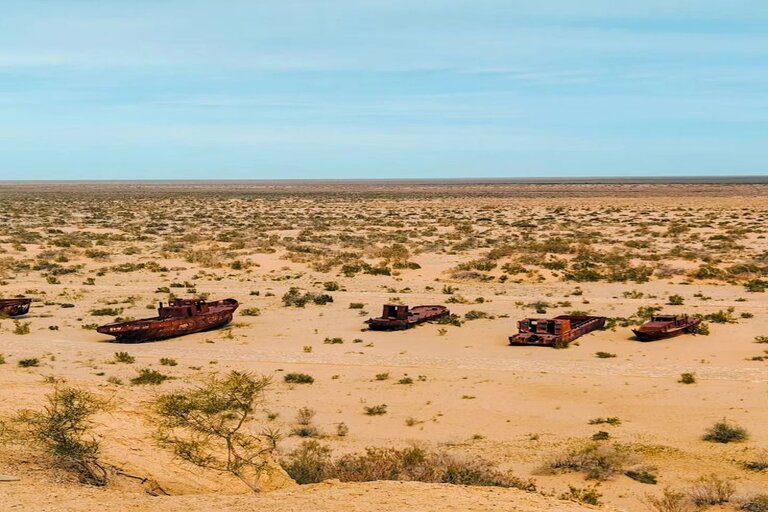
How the World’s Fourth Largest Lake Became a Deadly Desert
Aral sea,once the fourth largest lake in the world,has undergone a shocking change over the last 60 years. Once a huge and rich water mass is now a dry,dust dry.The story of the disappearance of Aral Sea is a story of environmental destruction that has had serious consequences for both nature and people.
The Aral Sea Before the 1960s:
Before the 1960s, the Aral Sea-the world’s fourth-largest lake-blinked over the borders of Uzbekistan and Kazakhstan.This vast water body covered some 68,000 square kilometers (26,000 square miles).By 2015, however,most of this lake was gone,and in its place was a hauntingly barren landscape,now called the Aralkum Desert.It has transformed into one of the most disturbing environmental calamities in the world, disturbing millions of lives and the ecosystem.
The Aral Sea’s Declining:
By the mid-20th century,the Aral Sea was a large and vital body of water.However,after large-scale irrigation projects began in the 1960s, the two main rivers feeding the lake the Amu Darya and Syr Darya were diverted for agricultural use.In the Soviet Union,the water that had been flowing into the lake was diverted to irrigate enormous cotton fields.As a result,the lake started to shrink.
The Aral Sea by 2024:
By 2024, a small portion of the original lake remained.What once was a lush body of water now becomes an enormous desert,leaving a seabed of bone-white salts and chemicals there.The waters have been decreased to just 8,000 square kilometers,and the rest has turned to be the Aralkum Desert.
The Environmental Crisis:
The collapse of the Aral Sea is not just a local disaster; This is a global environmental destruction.The loss of the lake almost doubled the level of atmospheric dust in the region from 1984 to 2015.This dust,which is now Hawaii,has damaged air quality in cities hundreds of miles away,even from east to 800 kilometers (500 miles).Lake.Dust contains harmful salts and chemicals that not only damage the soil,but also contribute to the glacier melting,causing the region’s water crisis to erase.
Crop destruction and water contamination:
These dust storms, carrying toxic dust,spread miles,destroying crops and contaminating drinking water. Aralkum Desert dust is much worse,as it carries extremely high levels of toxic chemicals that result from this region’s history of past chemical weapons testing during the Soviet era and fertilizers/pesticides from mass agricultural practices.
The Crisis of Salinity and Ecosystem:
The draining of Aral sea created another big question: rising salinity.As the water in the lake evaporated, the concentration of salt grew in the remaining water more than the sea,causing most of the original species of the lake to be destroyed.The collapse of the lake’s ecosystem destroyed the livelihood of thousands of people who depend on the lake for fishing.Rusty fishing boats,now trapped on dry sea,once serve as a tragic reminder of a wealthy industry.
The increase in salinity killed off aquatic life, and with the collapse of the fishing industry,local communities were left without their main source of income.Loss of the lake has had deep effects,making once-thriving communities struggling,desolate regions.
Health Impacts:
One of the worst effects on the health of people living close to the collapsed Aral Sea is the one caused by desert dust.Scientists have proven this dust to contain toxic substances leading to serious illnesses. Respiratory diseases,cancers,and abnormalities in newborn babies have become usual among the populations living close.The dust storms often carry damaging chemicals and salts that poison water meant for consumption and damage crops.
To try to address this problem, regional governments have been attempting to vegetate the former lakebed. Vegetation will help stabilize the soil and prevent toxic dust from spreading. Local scientists are trying to find species that can survive in salty soil, and international organizations such as the EU and USAid are helping.
The Aralkum Desert’s Formation:
When the water level in Aral Sea fell, the land that was once covered with water was a dry desert. Aralkam Desert is the current name for the area, which is expanding annually.The seabed has been exposed by the shrinkage of the sea, it has been changed into a scanty landscape filled with salt and chemicals.
A Global Warning:
The Aral Sea’s tragic fate is not just a local issue but a global warning. Similar problems are happening all over the world. Lakes and water systems in Africa, the Middle East, Europe, Australia, and the United States are all shrinking due to industrial agriculture and climate pressures. The Aral Sea is a stark reminder of what happens when water is poorly run and local environments are not prioritized.
The story of Aral sea should be an aroused call to governments, industries and individuals around the world. If we do not work quickly to solve the problems our water systems face, we can tolerate similar environmental disasters in other parts of the world.
Time to Act Before It’s Too Late:
This painful reminder of human activity on nature is the transformation of the Aral Sea into the Aralkum Desert. The disappearance of the lake brought ecological, economic, and health challenges to millions of people.The decline in Aral sea is a warning to all of us: We should prefer our environment and water systems to prevent future environmental crises. The world cannot ignore the lessons from Aral Sea.The time has come to take hold before it’s too late.
Subscribe & visit our website https://www.climatechallange.com/ for explore latest news & information about climate challenge & environment.